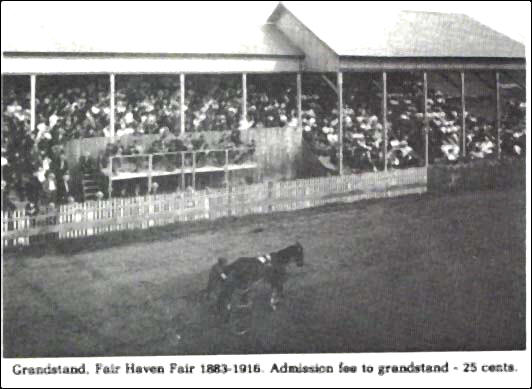
Courtesy of Dorothy St. John via Russ Farr
The old Fairmont Park horse track [and part - time fairgrounds, as it looked aroun d 1900. Below -
The site as it looked, after years of disuse, in 1947 - two years before Hugh Young used it.
BILL'S
[Somewhat] WEEKLY COLUMN/BLOG PAGE
BILL’S BACK IN TIME
By Bill Ladabouche
IT BEGAN AS JUST ANOTHER RACE
AT THE VERMONT STATE FAIR
By the time C. J. Richard, a farm kid from the western edge of Rutland County in Vermont had gotten old enough to realize there was something out there besides chores, the old horse track at the Vermont State had hosted open wheel auto races for quite some time. When Hugh Young, the Fair Haven farm equipment dealer who probably kept the Richards farm going decided to re – open the old Fairmont Park horse track, at the old fairgrounds, the elder Richards took the younger C.J. to see the show.
As it turned out, Young went through a 1949 season staging races, some of which involved the dangerous roadsters from New York. 1950 would see only stock cars – and some pretty good names, at that. The following year , after Marty Vinci was killed, watching the races from a tree bordering the race grounds, Young decided to fold his tents. It also didn't help that the new Pico Raceway, nearby in Rutland, was attracting a lot of the available race teams.

Courtesy of Dorothy St. John via Russ Farr
The old Fairmont Park horse track [and part -
time fairgrounds, as it looked aroun d 1900. Below -
The site as it looked, after years of disuse, in 1947
- two years before Hugh Young used it.
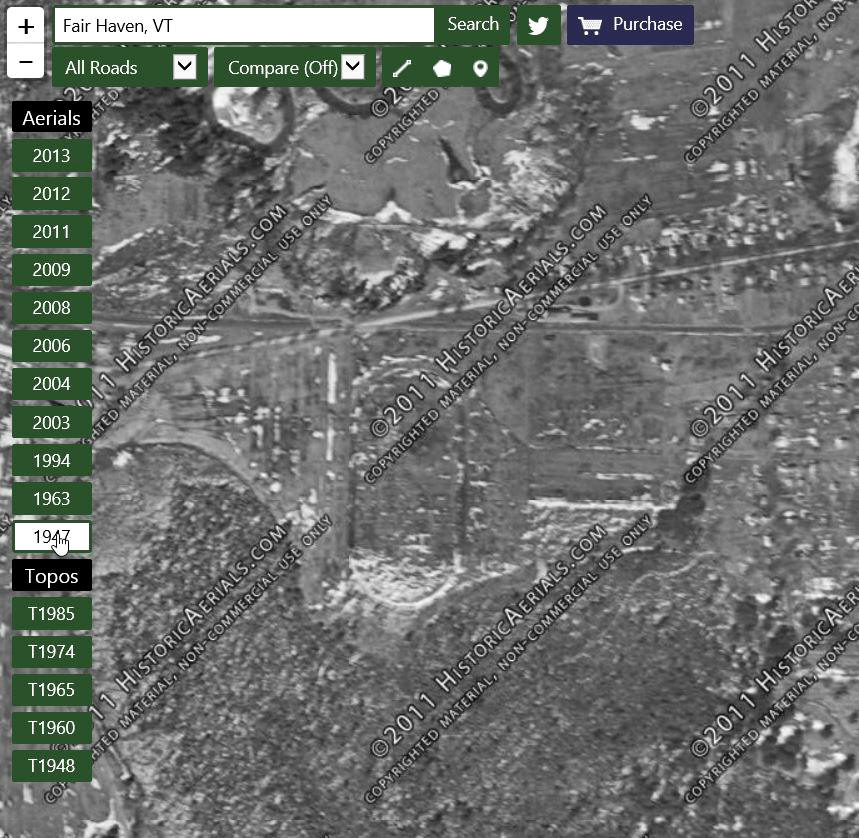
Historic Aerials.com
Young Richards, in the next year, did come and go from the area; and he also tried his luck at racing a few times – even as far north as Malletts Bay. I never found out what exactly made Richards choose 1962 as the year he would try his hand at promotion. I firmly believe he was influential in getting the Lebanon Valley Speedway group to stage a stock car race at the Vermont State Fair in 1961 – although I have no proof. I learned never to underestimate C.J.
At any rate, work began early in 1962 refurbishing old buildings, moving the judges' stand from the infield to the spectator side, and reviving a track that had sat, unused for ten years. After a successful start, Fairmont Speedway went through stages like putting in lights that had come from that same Pico Raceway. In the background, C.J. Was working the fair management to let him stage a race during fair week.
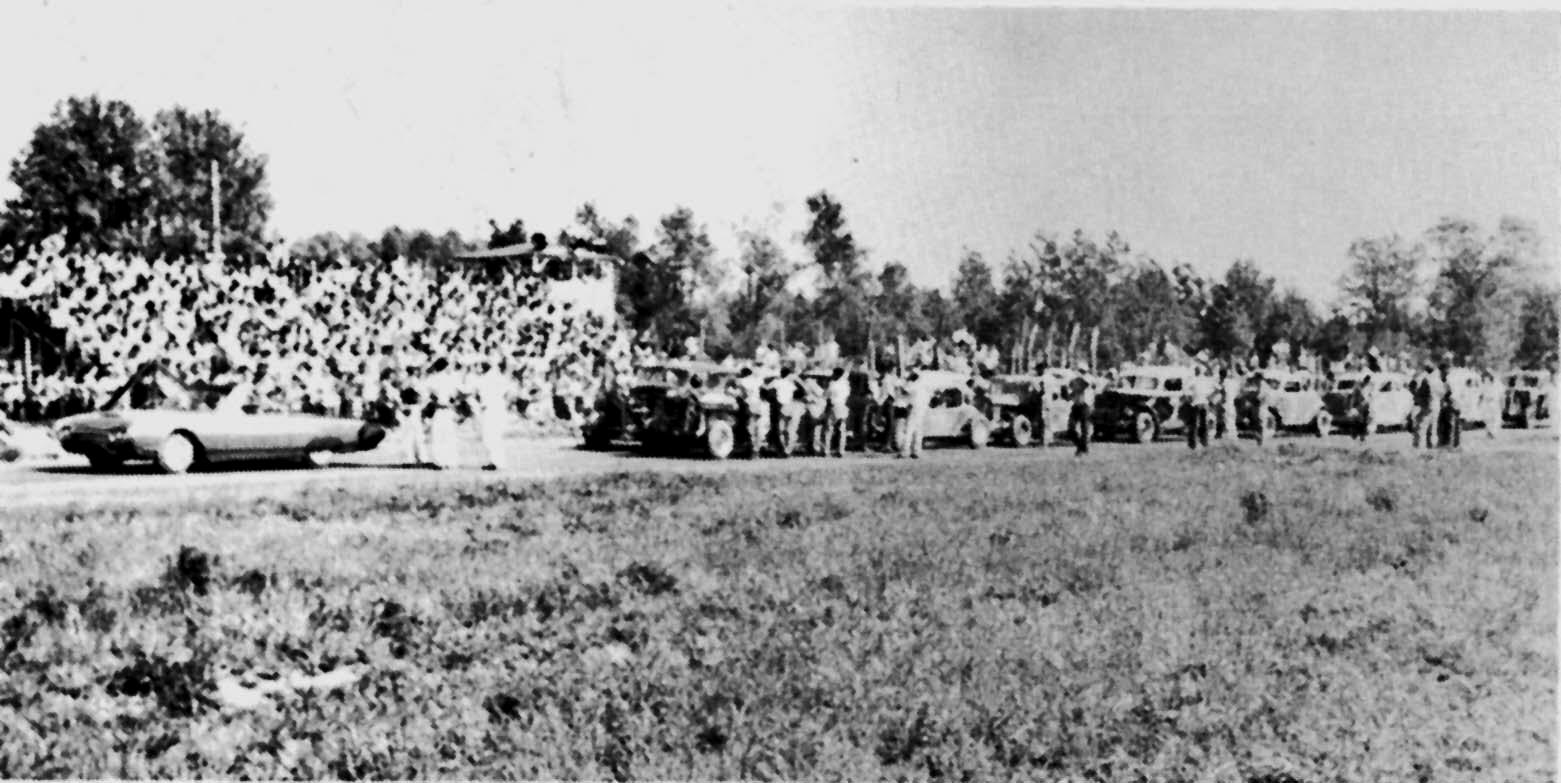
Courtesy of Norm Vadnais
With a borrowed Thunderbird pacing the way,
the first ever feature lineup for C.J. Richards' promotion assembles at
Fairmont Speedway. You can see an
overflow crowd and the fact that the announcer's stand is now in the
spewctator area rather than in the
infield. Below- C.J. poses proudly with his speedway sign.
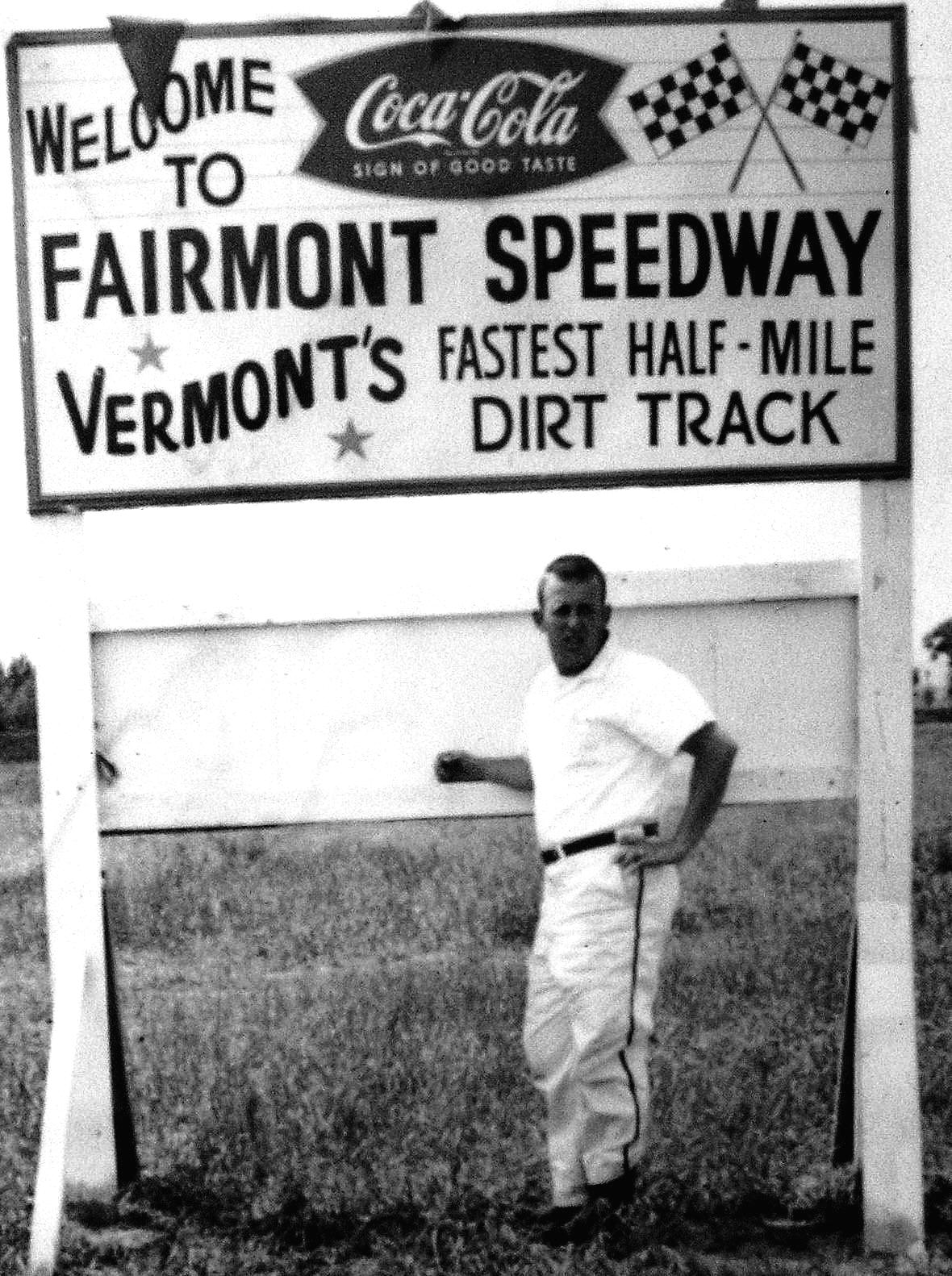
Likely a Bob Frazier Photo
Young Richards, in the next year, did come and go from the area; and he also tried his luck at racing a few times – even as far north as Malletts Bay. I never found out what exactly made Richards choose 1962 as the year he would try his hand at promotion. I firmly believe he was influential in getting the Lebanon Valley Speedway group to stage a stock car race at the Vermont State Fair in 1961 – although I have no proof. I learned never to underestimate C.J.
At any rate, work began early in 1962 refurbishing old buildings, moving the judges' stand from the infield to the spectator side, and reviving a track that had sat, unused for ten years. After a successful start, Fairmont Speedway went through stages like putting in lights that had come partly from that same Pico Raceway. In the background, C.J. Was working the fair management to let him stage a race during fair week.
Ladabouche Collection
Sprint cars, "big cars", and midgets made up
most of the racing before Lebanon Valley staged a show at the fair in 1961.
Below - The SCODA show was fun but one of the more
bizarre races I ever saw. Hybrid cars, at best. The feature
is flagged off by their own official starter.
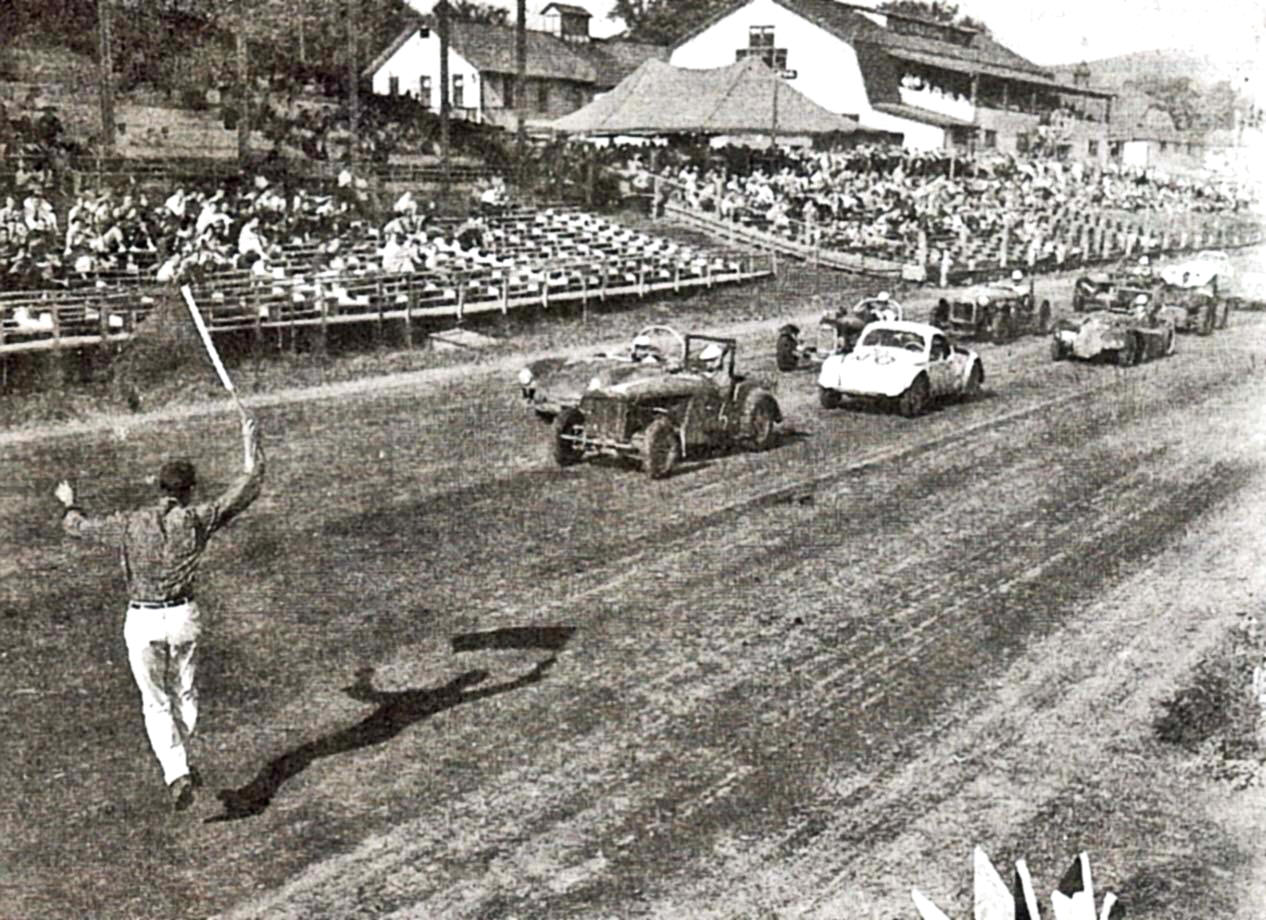
Aldo Merusi Photo for the Rutland Herald
C.J. once told me that he had no idea what he was getting himself into when he pushed to work with those who ran the Vermont State Fairgrounds in Rutland - with its archaic horse track that was, in no way set up for stock car racing. The fair committee had been pretty lucky with the Lebanon Valley show, although one car [which was unceremoniously crammed under the first turn fencing] barely missed the propane tanks behind Roxie's French Frys stand. The fair had had the usual racing, over the years - mostly in the form of midgets or sprint cars. In 1959 it had brought in the curious Sports Car Owners and Drivers' Association [SCODA] to stage a race and that had gone off without a hitch, featuring "sports cars' that looked more like European stock cars.
Richards must have advertised and cajoled because, while he didn't attract every one of his regular Fairmont teams, he did pull in at least ten or more teams who did not run with him regularly or at all. The majority of the “outsiders” seemed to come from Otter Creek Speedway, to the north near Vergennes, a track that seemed to be shedding its NASCAR sanction. [This may have been because Richards was romancing them behind the scenes. Otter Creek promoter Hi Monroe and his partner Lee Tucker were already wishing they had not started the project by the end of their first full year.
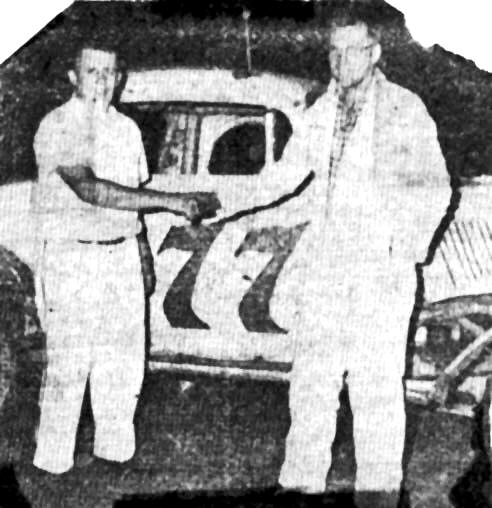
Aldo Merusi Photo for the Rutland Herald
C.J. appeared in
the Rutland Herald with this note that he had retained Lebanon Valley star
Johnny Flach
to race at Fairmont in 1962. Flach appeared seldom,
if at all - although Flach team mates Lou Searing
and Stan Wetmore would run Fairmont by 1963. Below -
Claremont Speedway standout Sonny
Rabideau had begun to run with Richards more
frequently by the end of the 1962 season. Once the guy who
was stuffed inthe fence in 1961, he would win the
Rutland fair race the following year.
Bob Frazier Photo via Norm Vadnais
Richards told me that he encountered a number of obstacles once he had landed the permission to stge the race program at the Rutland Fairgrounds. Firstly, there was that fact that some of his loyal teams were not attending the show; secondly, he was concerned about how unsuited for auto racing the old track was:, and then there was the fact that the fair insisted he use their ancient 1930's water truck instead of his own. The small truck could not keep up with the warm September sun that Sunday afternoon. This, plus delays that fed into the sun lowering significantly behind turn one, nearly caused his show to be aborted mid – feature.
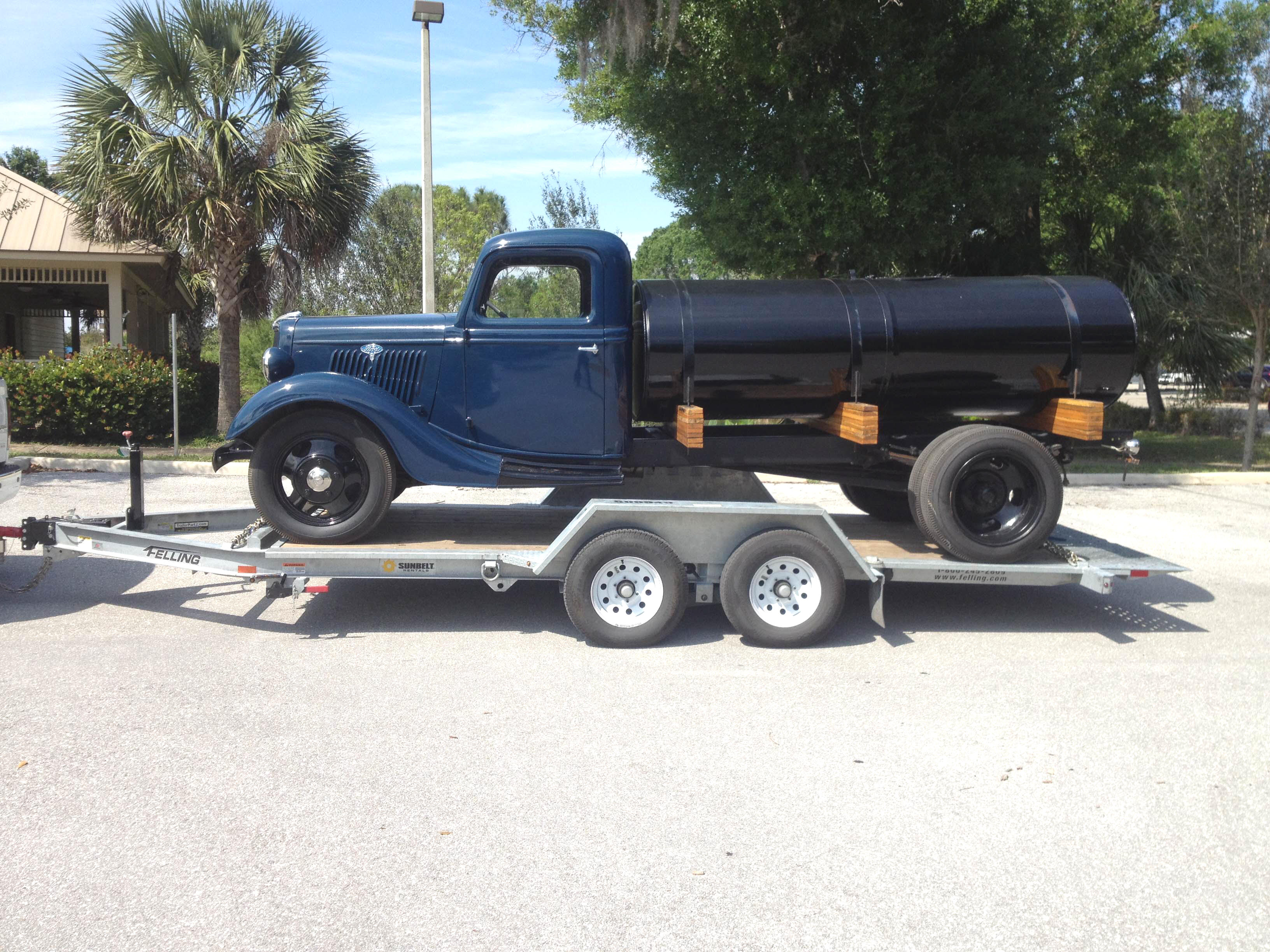
Courtesy of Manuel Guixens
The actual Rutland Fair water truck that C.J. had to contend with sits, restored. It
couldn't water enough to keep a vegetable patch wet.A crowd far larger than anyone had anticipated showed up. They filled the large old covered grandstands and the box seats in front; they filled every nook and cranny around the track fencing where they were allowed to stand; and they even filled the long stairs on the outside of the Arts and Crafts building. There was also a considerable number of spectators in the infield. Dealing with unfamiliar infrastructure and with a number of unfamiliar competitors – along with the extra time wasted trying to control dust with the hot wheels – sized water truck caused the program to be well behind schedule.
There have been varying reports of how many people finally crammed in to see that race in 1962. C.J. Told me that it was “over 10,000” and that it was the largest crowd ever to see a sporting event in the state of Vermont up to then – or for some time after. I have read somewhere where he had 20,000; I thin k that's a little generous. At any rate, the young promoter and his fair collaborators felt a profound pressure on them for the show to go well.
Courtesy of C.J. Richards
Danny Rumpf flags off the feature that day. Contrast the crowd size wtih the SCODA photo above.
Below - Sprinters raced at the same fairgrounds sometime within a year of the Richards
program. The fence is lined with free onlookers but the stands were not nearly as full.
Courtesy of Cho Lee
The qualifying races went off, but not without a few snags. In one heat, Phil Russell of Sudbury, VT used his tank – like black and yellow car # Checkmate to essentially clear the lightweight About 5 of Glens Falls. NY's Art Rivers out of his way. River's little white '34 Ford flew off sideways, rolling over the fragile little white picket fence that “protected” the infield in front of the Judges' Stand from the track. The Rivers car was scraped off the ground and hauled off while Russell appeared to get his ear chewed off by irritated officials who didn't want any more delays.
Sometime during the earlier portion of the show, they saw close to a perfect repeat of something that had happened in the Lebano Valley race the year before. The Valley regulars, long known for their resentment of outsiders invading their territory, had managed to take Claremont Speedway star Sonny Rabideau and stuff his small, cutdown #311 under the fencing in the first turn – barely missing the propane tanks behind Roxie's concession stand. Now, in the 1962, the exact thing happened to Vic Love, driving another lowslung coupe. It all was cleared up without any more trouble.
Courtesy of Wes MoodySomewhat nervous officials look on as Art Rivers tears up some of the fancy picket fencing
courtesy of Phil Russell's Checkmate Hudson speeding by. Below - This shot from the
covered stands shows Vic Love tucked into the fence not far from where Rabideau had
met the same fate a year before. Check out the Club 18 girlie show in the background.
Roxie's propane tanks are right by the Fried Clams sign at right.
Norm Vadnais PhotoIn the end, it sure looked like all the cars that could started the feature, as the day had worn on and the sun was now very low in the western sky – right in their eyes as they headed into turn one by Roxie's concession stand [the one with the propane tanks sitting just outside the flimsy fence. The race was flagged off by Richards' colorful stater, Danny Rumpf, a Chet Hames protege from Saratoga Springs, NY. It wasn't long at all before the dust was thick , with the sun shining through it. The inevitable happened right at the entrance to Turn One.
I don't know the cause, but the white #RR of Ray Richards [driven by veteran George Pritchard] was turned into the F4 Chevy of Gansevoort, NY's Beryl Fitzgerald. It was like a small Vermont version of a Talledega “big one”. Cars were scattered everywhere, with those lucky enough to have been far behind avoiding the carnage up front. It appeared as though a couple of guys from the infield had run out to the track apron to frantically flag down some of the cars in the back [including many of the best cars].
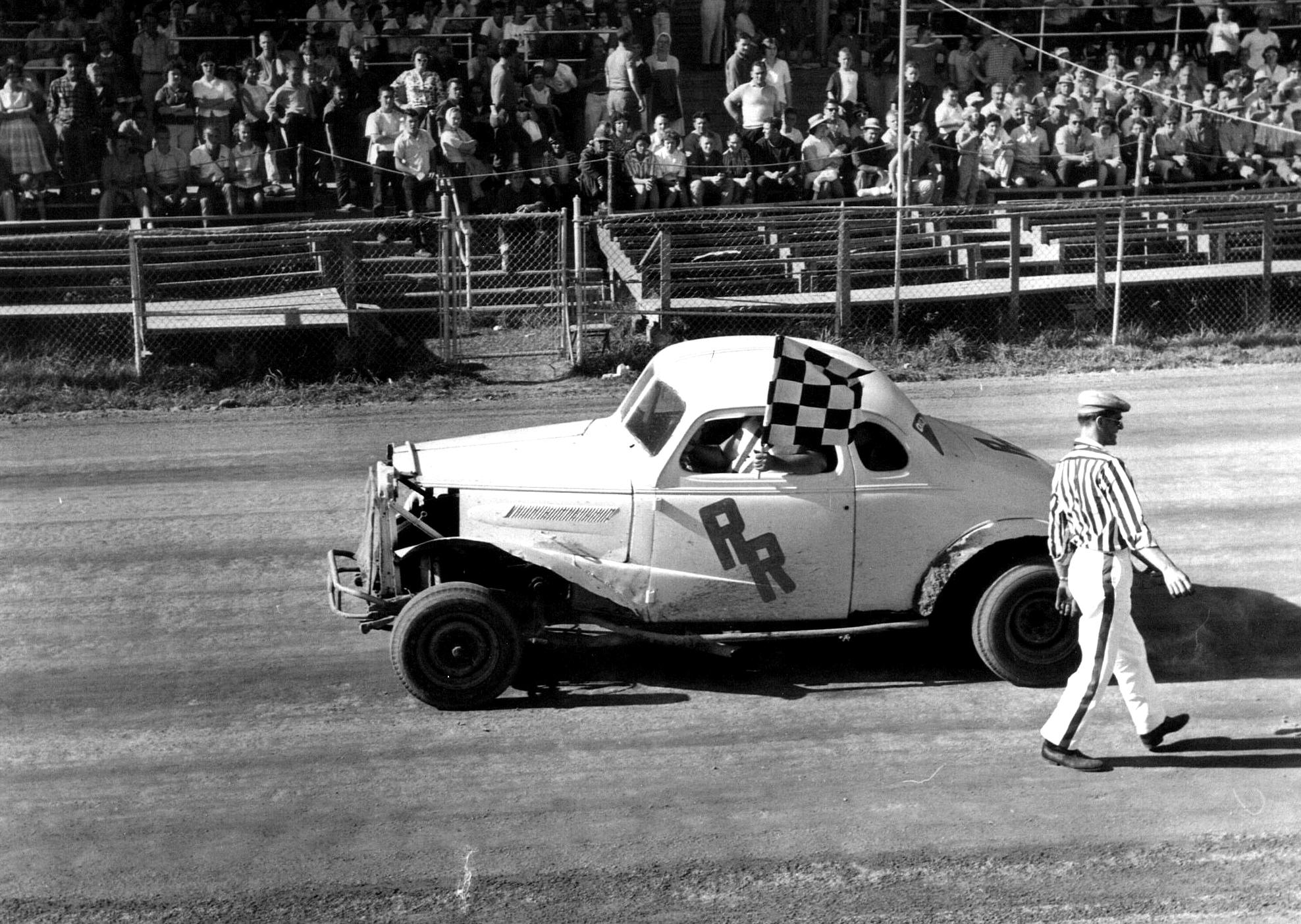
Photo Courtesy of C.J. Richards Photo Courtesy of the LaFond Family
[Above Left] Big George Pritchard took a heat win in Ray Richards' RR only to have the frame irreparably twisted in the early
race wreck at the end of the frontstretch [Above right] . Pritchard is in the dirty white T -shirt in mid photo, hands on hips.[ Below left] -
Ken Delong also won a heat and then was wiped out in that same pileup [Below right]. The photo shos him being checked on by Bob
Loomis, who rear - ended him the fracas. Joe D'Avignon wobbles away from his 8 Ball, flexing a sore arm.
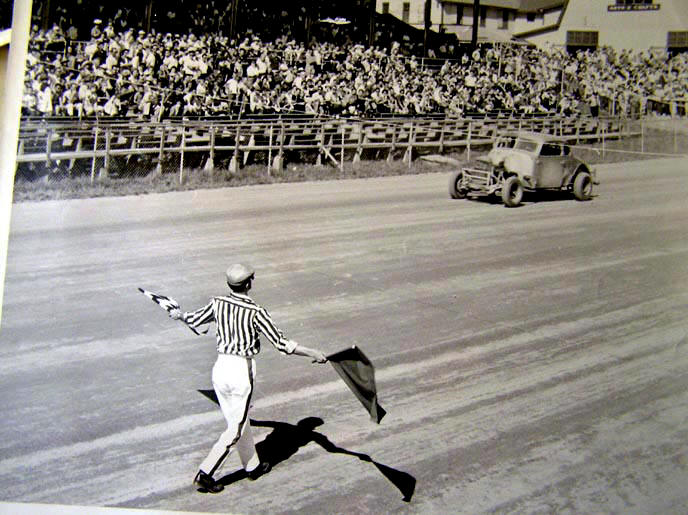
Photo Courtesy of C.J. Richards Photo Courtesy of the LaFond Family
The devastation was considerable, and they weren't done yet. The Fitzgerald car, which hadn't appeared at Fairmont much after the first few races of the year, was terminally twisted. The sharp, clean RR, which had won a qualifying race, had irreparable frame damage. [The body was strangely spared and would be used a Devil's Bowl car five years later]. Bob Loomis' P61 had been severely rearended by Ken Delong in the “Car 54”; the Loomis car had too much damage to continue and Delong was very shaken up. He was getting along in age and this might have been his last run. A yooung Johnny Spafford, who actually avoided much harm in that first pileup, would continue the race only to sell his blue #77 in 1963 and become the Fairmont Speedway push truck guy with his jeep.
Hustling pit crews were busy untangling cars such as Ed “Peanut” Foley's #30 and Jack Cutter's 95. These cars, which had both started out at Otter Creek in 1961, were pushed away by their crews. Little Joe D'Avignon, another man who drove at both tracks, walked gingerly through the carnage, shaking one arm. One could see small scenes on the track: Bill Stevens, whose S29 was untouched, was consoling big George Pritchard whose car was toast; Loomis had his head in the Car 54, checking on Delong; first timer Lennie Wood, in a car A11 which had never appeared at a Richards race before, sat in his untouched Ford taking it all in.
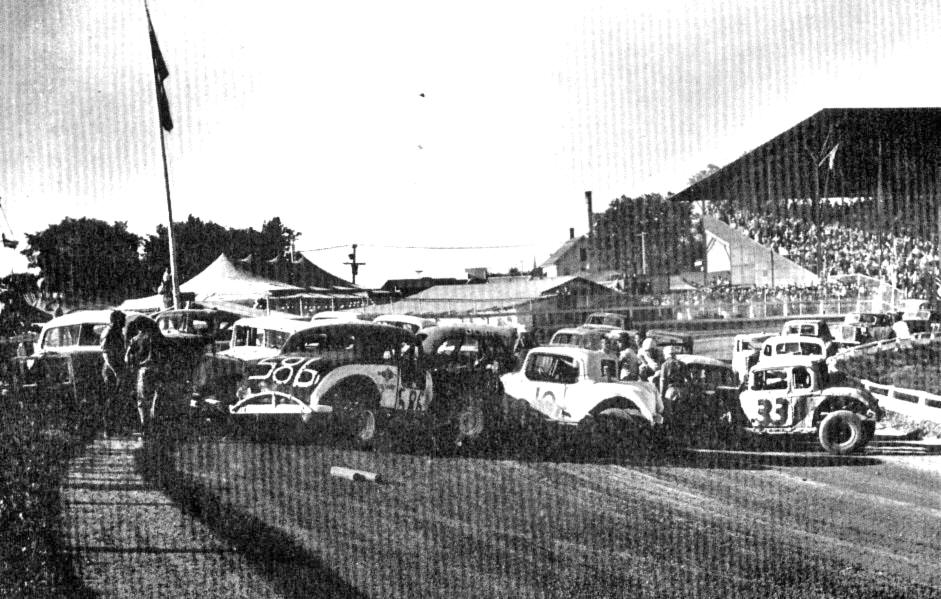
Courtesy of Ed Fabian
The results of the second big pileup. Bob Bushey's 586 sits crossed up in front of
a large pack of cars. Art Cody [33], one of the pre - race favorites, is involved. Others seen
include George Rogers, Vince Quenneville, Harry Hale [10] in Henry Abbott's old car, Ed
Baker, and more. Below - Norm Vadnais' shot from the stands shows cars still slowing
as the pileup starts to settle. Eventuial winner Rabideau is seen moving off, just ahead
of the carnage.
Norm Vadnais PhotoWhen the mess was cleared up, most of the field restarted and the action seemed to go a little better. Perhaps drivers were more careful or maybe they just got used to the lack of visibility. Then it happened again – this time a few dozen feet further, in Turn Two. It looks as if the massive 586 Hudson Terraplane of Bob Bushey got crossed up and was plowed by a number of cars which came into him at speed. Bushey, a 1950's star who still holds the record for the most wins in a season at Airborne Park Speedway, had a car owned by people from the Vergennes area and must have run Otter Creek.
This time, the Vermont State Police were becoming concerned that someone was going to really get hurt in the face of the dust and the sun problems. The trooper in charge must have told Richards that he was giving strong consideration to cutting the race short. Richards could be pretty persuasive, as could many others who didn't want to see this occur. Then, I am told it became clear that if they did abort the program, there was a real possibility the huge crowd was going to get pretty ugly.
Courtesy of the LaFond Family
C. J. 's father looks around in concern as the Wylie wreck occurs and the program is slowed again. Wylie's dark #107, seen in the
circled portion of the top photo. would be sold in a year and would become the famed 107 Moonlight Gambler of Roger Gauthier.
Below - The Wylie car sits peacefully in the infield pits before the races had begun.
Ladabouche Photo
I don't recall if any more water was added to the track under the red flag situation, but the race was finally resumed. At some point, Bruce Wylie, a regular at Claremont Speedway, had a wreck on the backstretch in which he was injured. One photo shows the father of C.J. Richards, standing on part of the stage in the infield, looking across at the Wylie accident, no doubt worried about how this was going to end up.
Finally, a very relieved Danny Rumpf threw the checkers over Rabideau, who had not run very many times at Fairmont yet but who was making a triumpant return to the fair track with the lowslung, black and white #311 Ford of Keene, NH's Frank “Stroker” Smith. Between Smith and Rabideau [a professional machinist for Angell's Automotive in Brattleboro], the team had some serious tech skills on board. Rabideau and Smith would then go on to win Richards' Vermont State Championship race at Fairmont late in the season. He would remain a strong presence on Richards' Champlain Valley Racing Association tracks for years to come – even giving the overhead V-8's a run for their money early in the 1965 season before they got the hang of running their new, unfamiliar cars.
Courtesy of C. J. Richards
Winner Sonny Rabidea barely has time to get the trophy from a drained C.J. Richards
and get in a photograph before a portion of the huge crowd descends on them. Below -
This photo, which shows the racing community from around Castleton, VT includes such as George
Rogers, the Vadnais brothers, Ken Boutwell, Don Ballantine, John Spafford, and more. The shot
reflects the high expectations for that late season race. Rogers' UP2 is at right. An unfamiliar car
13 [not Buddy Bardwell] is seen behind them
Courtesy of Norm VadnaisA very tired and thankful – looking C.J. Richards was photographed giving Rabideau the winning hardware in a very brief Victory Lane. Firstly, everyone was too tired for much fanfare and – more importantly – a good portion of the huge crowd can be seen in the background, spilling out of the spectator areas and towards the victorious driver and car.
There were many results of this ultimately success program put on at the fair by Richards. Firstly, he would stage at least three more such shows. Although he did have to share the track with Harvey Tattersall's Grand American division of the United Stock Car Racing Club in 1963, the Richards show went off with more acceptance and interest. Tattersall's race was marred by the fact that the larger late model cars were just too big and heavy for the facility. Bob Devine, who had run third all afternoon, went off the backstretch, through the fence, and severely injured a woman who was just getting something out of the trunk of her car.
Courtesy of Sam Barlow
Bob Devine broadslides the same '61 Chevy he crashed at a 1963 Rutland fair show. Below -
Another Norm Vadnais photo shows Jerry Townley winning what might have been the
last of C. J.'s fair shows. Itwas prophetic, as the overhead V-8 sportsman [like
Townley's Tom Chewins - owned 108] would take over in 1965. Note the fair has had
enough sense to get rid of the picket fencing by now.
Courtesy of Norm VadnaisI believe the 1964 show, which was won by Jerry Townley of Catskill, NY with an overhead V-8 NASCAR sportsman coupe, was the last such race at the Vermont State Fairgrounds. Richards' involvement with Otter Creek Speedway would also ramp up in 1963, before letting the track sit idle the following year. Perhaps the greatest effect of the large but difficult show held in 1962 was its addition to the long list of arguments against staging car races at the fair any more.
The 1962 problems; the Devine accident in 1963, coupled with another accident at the race Richards staged in 1963 in which a pedestrian walking on South Main Street was struck and critically injured by a wheel off the car of Athol, NY's Ed Baker; and the dust and noise from the races added up to the fair board's decision to not allow any more auto racing. Richards would closed up Fairmont in 1966 and establish the still – operating Devil's Bowl Speedway in 1967. Richards would be handling the controls in the background in 1965 when Otter Creek opened up as Hillside Raceway, promoted by Joe D'Avignon, one of the men who raced at the fair in 1962.
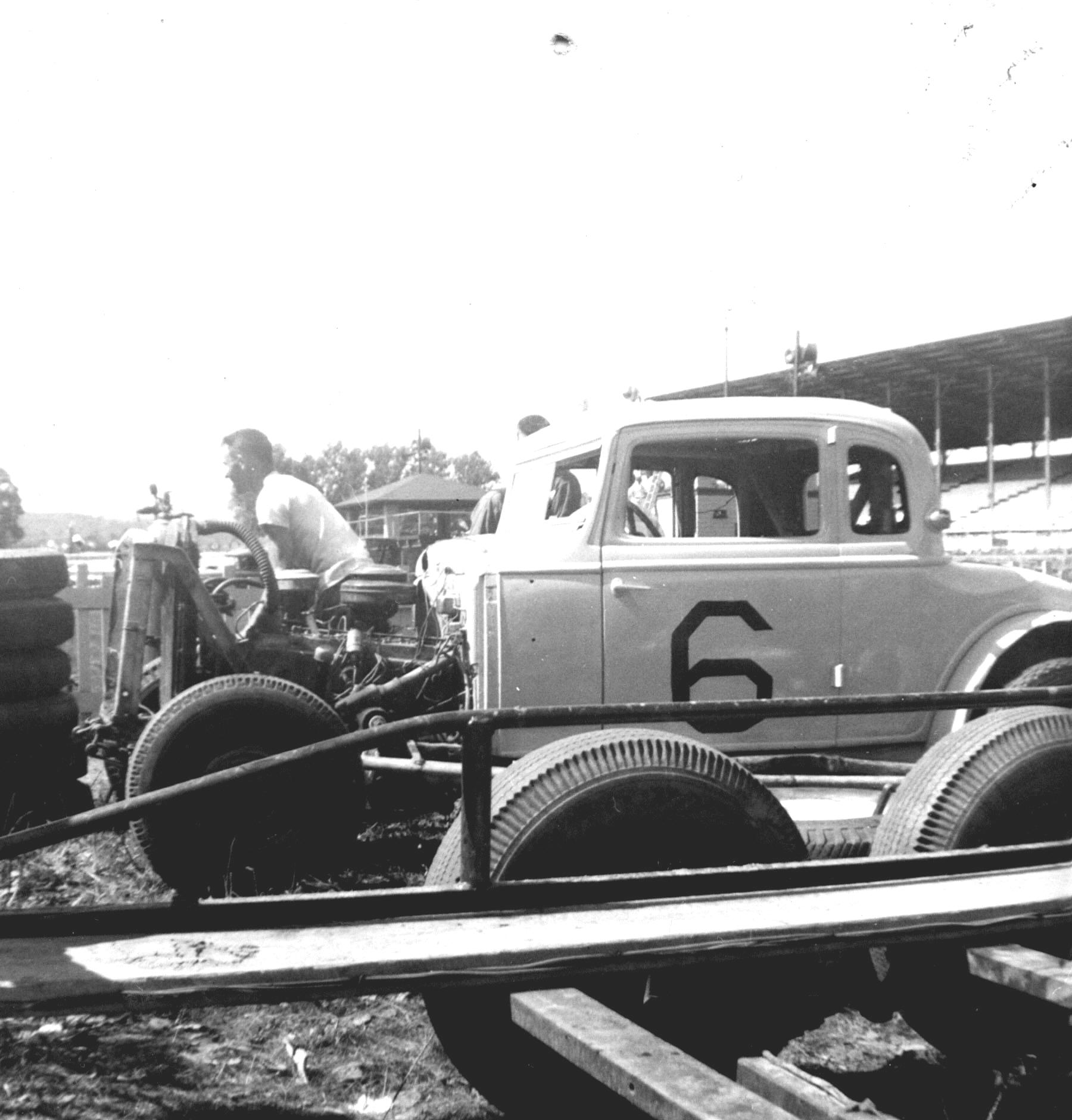
Ladabouche Photos
[Above left] Vern Baker fusses around Ed Baker's [no relation] 6 PAC before the 1962 race at the fair. [Above right] Vern is still fussing in
1963, with the car, which now had fenders. Ths is the version that threw the wheel off at the fairgrounds race. Below - A race runs off
at Hillside Raceway in 1965 with many of the same cars that ran Fairmont. No more fair racing by that time.
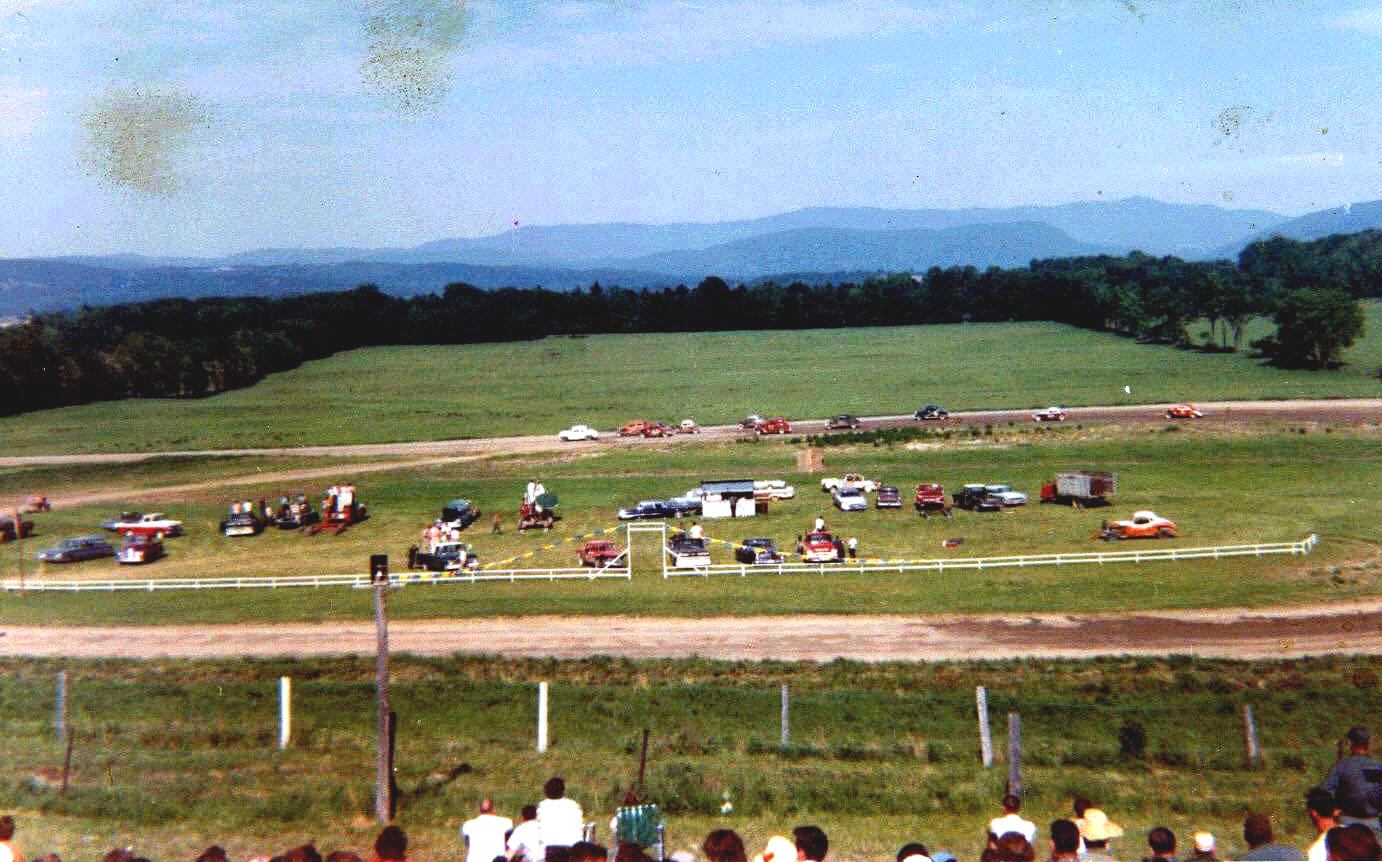
Photo Source Unknown
Other stories played out from that race. A young and unknown Lenny Woods, from the Pawlet / Dorset area of Vermont sat in his first race car that day – the never – before – seen A11 of Ralph Morse, from Sunderland, VT. Brother to the well – known 1950's star Charlie Morse, Ralph had spent time working with the race efforts of Manchester, VT's Dave Brooks, another '50's legend. The young driver would go on to become “The Unbeatable Lenny Woods”, who had a run in the Fairmont hobby division of almost an entire season without losing.
Bob Bushey, a huge name in northern Vermont and New York racing in the mid 1950's, would all but disappear after the fair race. George Pritchard would be pretty much done with racing, as well, while the body off his #RR became the body on Beaver Dragon's famed #75 coupe at Devil's Bowl for two seasons. Besides Pritchard, racing pioneer Ken “Pappy” Delong would cash it in after his crash at the fair. The Loomis brothers, into whose car he crashed, would grab veteran driver Nelson Moore and have great success with other cars P61 and 111.
Courtesy of Dave Wood
The Unbeatable Lennie Wood wins on at Hillside Raceway in 1965. He won every feature he finished at
Fairmont Speedway that year in John Maguire's F30. Below - The Loomis brothers' 111 was
very dominant in the hands of Nelson Moore at Fairmont around 1964.
Ladabouche PhotoEd Foley, the Leicester, VT driver who had started quietly at Otter Creek in 1961, driven at that track and at Fairmont in 1962, and had avoided all the wrecks at the fair in September, would go on to better cars [finally with well – heeled car owners] and would have a strong career at Devil's Bowl and Lebanon Valley. Many of the other hobby teams from that initial Otter Creek season of 1961, such as Jack Cutter, Ed Magoon, Bob Russell, Phil Russell, and more would soon fade off – not wanting to travel to Fairmont.
That show in 1962 attracted cars CVRA fans did not always see. In addition to the Otter Creek brigade, the Morse A11, and so forth – there were some cars I still have not been able to identify all these 55 years later. There are three shots involving a 1949 or 1959 Ford numbered 30. No one seems to remember the car. It even made a photo in the Rutland Herald the next day. Also, there are still two other cars I cannot ID: a 1937 Ford which appears to be #X and another '37 Ford #13. These have nothing to do with Buddy Bardwell or Butch Jelley. I have asked them both.
Bob Mackey Photo via John Rock
Some of the Otter Creek Speedway regulars who would race at the fair in September are seen in this shot,
desperately trying to outrun the overhead V-8 sportsman cars which are closing in. Ed Foley [30], Jack
Cutter [95], Vince Quenneville [2nd from left] and Bob Russell [3rd from left]. Below - The mystry car
30 is seen in a heat with Otter Creek regulars Phil Rusell [Checklmate] and Joe D'Avignon [8 Ball].
Norm Vadnais PhotoThere is still considerable interest in that big CVRA show at the Vermont State Fair in 1962, although the numbers of folks who can actually recall it or who can say they were there is shrinking rapidly. Richards is gone; Danny Rumpf is gone; Sonny Rabideau is gone; and easily 65% of those who played a part in that day are gone, too. The track at the fairgrounds is in declining condition – as is the fair itself. Fairmont Speedway, the host of the program closed, and Devil's Bowl was born.
Otter Creek, sort of the other host track, lasted until 1963. Then, it was reborn as Hillside Raceway for a season under Joe D'Avignon and went through another, unsuccessful life around 1970 as Rainbow Ridge Raceway under driver / promoter Louie Senecal. It had been hoped that, because Devil's Bowl went to pavement in 1970, Senecal could offer a place for dirt racers at his track. It didn't pan out.
Courtesy of Diana PetersA look down at the track during the brief RFainbow Ridge Raceway era.
It could be argued that the CVRA race at the Vermont State Fair in 1962 was a seminal moment in Vermont racing and that it is one of the single most important racing programs ever held in Vermont. In my rare opportunities to get C.J. Richards [then in declining health] to sit still and actually reflect on his career as a promoter, he would often turn to this program in his conversations, giving me proof that this was one of his benchmark moments in nearly forty years of promotion.
Courtesy of Norm VadnaisPlease email me if you have any photos to lend me or information and corrections I could benefit from. Please do not submit anything you are not willing to allow me to use on my website - and thanks. Email is: wladabou@comcast.net . For those who still don’t like computers - my regular address is: Bill Ladabouche, 23 York Street, Swanton, Vermont 05488.
AS ALWAYS, DON’T FORGET TO CHECK OUT MY WEBSITE
www.catamountstadium.com
Return to the Main Page
Return to the Main News Page
Return to the All Links Page
Return to the Weekly Blog Links Page